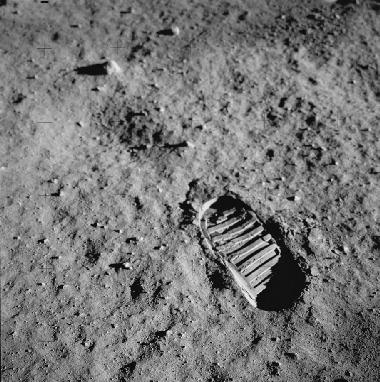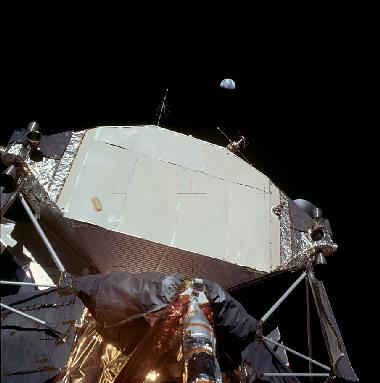-
 Buzz Aldrin (LMP)
Buzz Aldrin (LMP)
-
Okay. You do have to be rather careful to keep track of where your center of mass is. Sometimes, it takes about two or three paces to make sure you've got your feet underneath you.
-
 Buzz Aldrin (LMP)
Buzz Aldrin (LMP)
-
About two to three or maybe four easy paces can bring you to a nearly smooth stop. *** change directions, like a football player, you just have to to *** foot out to the side and cut a little bit.
-
 Buzz Aldrin (LMP)
Buzz Aldrin (LMP)
-
So-called kangeroo hop does work, but it seems that your forward mobility is not quite as good as—it is in the conventional—more conventional one foot after another.
-
 Buzz Aldrin (LMP)
Buzz Aldrin (LMP)
-
It's hard saying what a sane pace might be. I think it's the one that I'm using now—would get rather tiring after several hundred *** but this may be a function of this suit, as well as lack of gravity forces.
-
 Bruce McCandless (CAPCOM)
Bruce McCandless (CAPCOM)
-
Tranquility Base, this is Houston. Could we get both of you on the camera for a minute, please?
-
 Bruce McCandless (CAPCOM)
Bruce McCandless (CAPCOM)
-
Roger. We'd like to get both of you in the field of view of the camera for a minute.
-
 Bruce McCandless (CAPCOM)
Bruce McCandless (CAPCOM)
-
Key moment President Nixon speaks to Neil and Buzz on the Moon: Neil and Buzz, the President of the United States is in his office now and would like to say a few words to you. Over.
-
 President Nixon
President Nixon
-
Neil and Buzz, I am talking to you by telephone from the Oval Room at the White House, and this certainly has to be the most historic telephone call ever made. I just can't tell you how proud we all are of what you *** for every American. This has to be the proudest day of our lives. And for people all over the world, I am sure they, too, join with Americans in recognizing what an immense feat this is. Because of what you have done, the heavens have become a part of man's world. And as you talk to us from the Sea of Tranquility, it inspires us to redouble our efforts to bring peace and tranquility to Earth. For one priceless moment in the whole history of man, all the people on this Earth are truly one; one in their pride in what you have done, and one in our prayers that you will return safely to Earth.
-
 Neil Armstrong (CDR)
Neil Armstrong (CDR)
-
Thank you, Mr. President. It's a great honor and privilege for us to be here representing not only the United States but men of peace of all nations, and with interest and a curiosity and a vision for the future. It's an honor for us to be able to participate here today.
-
 President Nixon
President Nixon
-
And thank you very much and I look forward—All of us look forward to seeing you on the Hornet on Thursday.
-
 Bruce McCandless (CAPCOM)
Bruce McCandless (CAPCOM)
-
Roger. P22 landmark ID, LM: T1, 110 26 56; T2, 110 32 06. Three miles south; time of closest approach, 110 33 40. Shaft 353.855, trunnion 46.495, roll zero, pitch 250, yaw zero. Over.
-
 Buzz Aldrin (LMP)
Buzz Aldrin (LMP)
-
Houston, it's very interesting to note that when I kick my foot *** with no atmosphere here, and this gravity *** they seem to leave, and most of them have about the same angle of departure and velocity. From where I stand, a large portion of them will impact at a certain distance out. Several *** the percentage is, of course, that will impact *** different regions *** it's highly dependent upon *** the initial trajectory upward *** where most of the *** already the particles are found, … terrain.
-
 Bruce McCandless (CAPCOM)
Bruce McCandless (CAPCOM)
-
Roger, Buzz. And break. Break. Columbia, this is Houston. When you track out of high gain antenna, then let's request OMNI Delta, OMNI Delta. Over.
-
 Buzz Aldrin (LMP)
Buzz Aldrin (LMP)
-
I've noticed several times in going from the sunlight into the shadow, that just as I go in, I catch an additional reflection off the LM *** along with the reflection off my face onto the visor, makes visibility very poor just at the transition *** sunlight into the shadow. I essentially have so much glare coming onto my visor *** shadow *** helmet actually gets the shadow. Than it takes a short while for my eyes to adapt to the lighting conditions. *** inside the shadow area, visibility, as we said before, is not too great, but both visor's up *** what sort of footprints we have and the general condition of the soil. Then, after being out in the sunlight a while, it takes—Watch it, Neil! Neil, you're on the cable.
-
 Buzz Aldrin (LMP)
Buzz Aldrin (LMP)
-
Yes. Lift up your right foot, right foot. It's still—your toe is still hooked in it.
-
 Buzz Aldrin (LMP)
Buzz Aldrin (LMP)
-
The blue color of my boots has completely disappeared now into this *** still don't know exactly what color to describe this other than ash cocoa color. It seems to be covering most of the lighter part of the boot *** color that *** very fine particles ***.
-
 Bruce McCandless (CAPCOM)
Bruce McCandless (CAPCOM)
-
Buzz, this is Houston. You're cutting out on the end of your transmissions. Can you speak a little more closely into your microphone? Over.
-
 Buzz Aldrin (LMP)
Buzz Aldrin (LMP)
-
In general, time spent in the shadow doesn't seem to have any *** thermal effects. *** inside the suit. There is a difference, of course, in the … radiation and the helmet. So I think there's a tendency to feel a little cooler in the shadow than the Sun.
-
 Bruce McCandless (CAPCOM)
Bruce McCandless (CAPCOM)
-
Roger. You should have VHF AOS with the LM right about now. VHF LOS will be about 40 minutes 15 seconds. Over.
-
 Buzz Aldrin (LMP)
Buzz Aldrin (LMP)
-
As I look around the area, the contrast, in general, is *** comes about completely by virtue of the shadow *** down Sun … very light colored gray, light gray color, a halo around my own shadow, around the shadow of my helmet. Then, as I look off across *** the contrast becomes strongest in that the surrounding color is still fairly light. As you look down into the Sun *** a larger amount of *** shadowed area is looking toward us. The general color of the *** surrounding *** the contrast is not as great. Surveying all the dusty area that we've kicked up *** considerably darker in texture. Now, I've kicked up one, and I imagine that this is *** Surveyor. The same is true when I survey across on—along the area that we're walking. In general *** to the fact that there are footprints there. General terrain where I've been kicking up a lot of this surface material is generally of a darker contrast *** color.
-
 Buzz Aldrin (LMP)
Buzz Aldrin (LMP)
-
And right in this area, there are two craters. The one that's right in front of me now as I look off in about the eleven o'clock position from the spacecraft, about 30 to 35 feet … There's several eral rocks and boulders 6 to 8 inches across … sizes.
-
 Neil Armstrong (CDR)
Neil Armstrong (CDR)
-
Bulk sample is just being sealed.
Expand selection down Contract selection up -
 Michael Collins (CMP)
Michael Collins (CMP)
-
Roger. No marks on the LM that time. I did see a suspiciously small white object whose coordinates are —
-
 Michael Collins (CMP)
Michael Collins (CMP)
-
Easy—Easy 0.3, 7.6, but I … right on the southwest end of a crater. I think they would know it if they were in such a location. It looks like their LM would be pitched up quite a degree. It's on the southwest wall of a smallish crater.
-
 Bruce McCandless (CAPCOM)
Bruce McCandless (CAPCOM)
-
Columbia, this is Houston. While I'm talking to you, LOS will be at 111 19 31; AOS, 112 05 43. Over.
-
 Buzz Aldrin (LMP)
Buzz Aldrin (LMP)
-
The jet deflector that's mounted on quad 1 seems to be a good bit more wrinkled *** right now on quad 4.
-
 Buzz Aldrin (LMP)
Buzz Aldrin (LMP)
-
I say the jets deflector that's mounted on quad 4 seems to be—the surface of it seems lo be more wrinkled than the one that's on quad 1. Generally, underneath part of the LM seems to have stood up quite well to the *** get some pictures in the aft part of the LM that will illuminate the thermal effects much better than we could get them up here in the front.
-
 Buzz Aldrin (LMP)
Buzz Aldrin (LMP)
-
And, Houston? Buzz here. I'm showing 3.78 psi, 63 percent, no flags, adequate, slight warming *** fingered.
-
 Neil Armstrong (CDR)
Neil Armstrong (CDR)
-
Roger. And Neil has 66 percent O2, no flags, minimum cooling, and the suit pressure is 382.
-
 Bruce McCandless (CAPCOM)
Bruce McCandless (CAPCOM)
-
Buzz, this is Houston. Have you removed the closeup camera from the MESA yet? Over.
-
 Bruce McCandless (CAPCOM)
Bruce McCandless (CAPCOM)
-
Roger. It looks like you're about a half hour slow on it. We're working on consumables. Over.
-
 Bruce McCandless (CAPCOM)
Bruce McCandless (CAPCOM)
-
Neil and Buzz, this is Houston. To clarify my last, your consumables are in good shape at this time. The 30 minute reference was with respect to the nominal timeline. Over.
-
 Neil Armstrong (CDR)
Neil Armstrong (CDR)
-
I don't note any abnormalities in the LM. The pods seem to be in good shape. The primary and secondary struts are in good shape. Antennas are all in place. There's no evidence of problem underneath the LM due to engine exhaust or drainage of any kind.
-
 Buzz Aldrin (LMP)
Buzz Aldrin (LMP)
-
It's very surprising, the very surprising lack of penetration of all four of the foot pads. I'd say if we were to try and determine just how far below the surface they would have penetrated, you'd measure maybe 3 inches, wouldn't you say, Neil?
-
 Buzz Aldrin (LMP)
Buzz Aldrin (LMP)
-
I get a picture of the plus Y strut taken from near the descent stage, and I think we'll be able to see a little bit better what the thermal effects are. Seem to be quite minimal.
-
 Buzz Aldrin (LMP)
Buzz Aldrin (LMP)
-
There's one picture taken in the right rear of the spacecraft looking at the skirt of the descent stage, shows a quite darkening of the surface color, a rather minimal amount of radiating or etching away or erosion of the surface. On descent, both of us remarked that we could see a large amount of very fine dust particles moving out. It was reported beforehand that we would probably see an upgassing from the surface after actual engine shutdown, but as I recall, I was unable to confirm that.
-
 Buzz Aldrin (LMP)
Buzz Aldrin (LMP)
-
We're back at the minus Z strut now. *** very little force of impact that we actually had.
-
 Buzz Aldrin (LMP)
Buzz Aldrin (LMP)
-
I was saying that, Houston, *** stop and take a photograph or something and then want to start moving again sideways, there's quite a tendency to start doing it with just gradual sideways hops until you start getting ***
Spoken on July 21, 1969, 4:03 a.m. UTC (55 years, 4 months ago). Link to this transcript range is: Tweet



